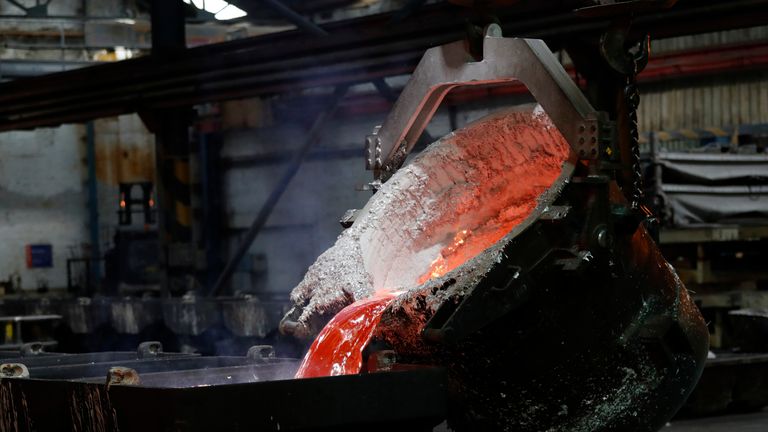Trump’s steel and aluminium tariffs target a deeper issue – but risk job losses and higher prices

There are countless examples throughout history of countries defying economic
logic in search of other goals. But it’s hard to see how tariffs won’t be
significantly inflationary, at least in the short term.
Economics and data editor @EdConwaySky [http://twitter.com/@EdConwaySky]

Monday 10 February 2025 19:40, UK
Please use Chrome browser for a more accessible video player

This is a modal window.

Beginning of dialog window. Escape will cancel and close the window.

End of dialog window.
This is a modal window. This modal can be closed by pressing the Escape key or
activating the close button.
This is a modal window. This modal can be closed by pressing the Escape key or
activating the close button.
Few materials matter quite as much as steel and aluminium.
Steel, an alloy of iron and carbon, is the main metallic ingredient in the
structures we live in and the bridges we build. If it’s not made of steel it’s
made with steel.
Aluminium, on the other hand, is a wonder material we use with wild abandon
these days. A light metal we use in planes and trains, in the bodies of electric
vehicles [https://news.sky.com/topic/electric-cars-6756] and in those high
voltage power lines we’ll need so many of to provide electricity in the coming
years.
Money blog: The 10 jobs crying out for applicants
[https://news.sky.com/story/money-inflation-interest-rate-mortgage-consumer-news-butcher-michelin-cheap-eats-live-13040934]
Please use Chrome browser for a more accessible video player
This is a modal window.
Beginning of dialog window. Escape will cancel and close the window.
End of dialog window.
This is a modal window. This modal can be closed by pressing the Escape key or
activating the close button.
This is a modal window. This modal can be closed by pressing the Escape key or
activating the close button.
All of which is to say these metals are the bedrock for much of the world around
us. And like most developed economies, the US is far from independent when it
comes to these materials. The degree of dependence on other countries varies
between them.
According to the US Geological Survey, America’s “net import reliance ratio” for
aluminium is close to 50%, implying it is deeply dependent on imports to satisfy
demand among its companies. The degree of dependence is considerably lower for
steel – only a little over 10%.
At least part of the idea behind tariffs
[https://news.sky.com/story/trump-reiterates-desire-to-make-canada-51st-state-and-says-he-will-impose-tariffs-on-steel-and-aluminium-imports-13306144]
is to bring some production back to the US, but imposing them will have
consequences.
What kinds of consequences? Well, at its simplest, tariffs push up prices. This
is, when you think about it, blindingly obvious. A tariff is a tax on a good
entering the country. So if aluminium and steel are going up in price then that
means, all else equal, that the cost of making everything from aircraft wings to
steel rivets also goes up. That in turn means consumers end up paying the price
– and if a company can’t make ends meet in the face of these tariffs, it means
job losses – possibly within the very industrial sectors the president wants to
protect.
So says the economic theory. But in practice, economics isn’t everything. There
are countless examples throughout history of countries defying economic logic in
search of other goals. Perhaps they want to improve their national self-reliance
in a given product; perhaps they want to ensure certain jobs in cherished areas
or industries are protected. But nothing comes for free, and even if Donald
Trump [https://news.sky.com/topic/donald-trump-5711]’s tariffs succeed in
persuading domestic producers to smelt more aluminium or steel, such things
don’t happen overnight. In the short run, it’s hard to see how these tariffs
wouldn’t be significantly inflationary.
There’s a deeper issue here, which comes back (as so many of Mr Trump’s economic
measures do) to China [https://news.sky.com/topic/china-5869]. Both the steel
and aluminium markets have faced enormous influxes of cheap Chinese metals in
recent years – to the extent that in recent months those Chinese imports have
actually been cheaper than the cost of production in Europe.
To some extent, that’s a consequence of high European energy costs, but it’s
partly down to the fact that China subsidises its producers more than most other
countries around the world. Indeed, of all the products in the world, few have
had as many cases lodged at the World Trade Organisation as steel.
Read more:
Why China could benefit most from Trump’s tariffs
[https://news.sky.com/story/why-china-could-benefit-most-from-trumps-tariffs-13306581]
Tax hikes and financial gloom ‘acting as brakes’ on jobs
[https://news.sky.com/story/budget-tax-hikes-and-financial-gloom-acting-as-brakes-on-employment-13306495]
Follow our channel and never miss an update
But while it’s worth being aware of these dynamics, which are pushing cheap
steel into many markets, it’s also worth noting that the US actually imports far
less from China than you might have thought. The vast majority of American
aluminium imports, for instance, come from Canada rather than China. Any tariffs
on the metal would further undermine the economic relationship between these
parts of North America.
Much, of course, now depends on the structure and detail of these tariffs – and
the extent to which they’re actually implemented. As with his threatened tariffs
on Canada [https://news.sky.com/topic/canada-6330] and Mexico
[https://news.sky.com/topic/mexico-6001], these ones raise as many questions as
they answer. That is likely to be the way of things for much of this
presidential term.




